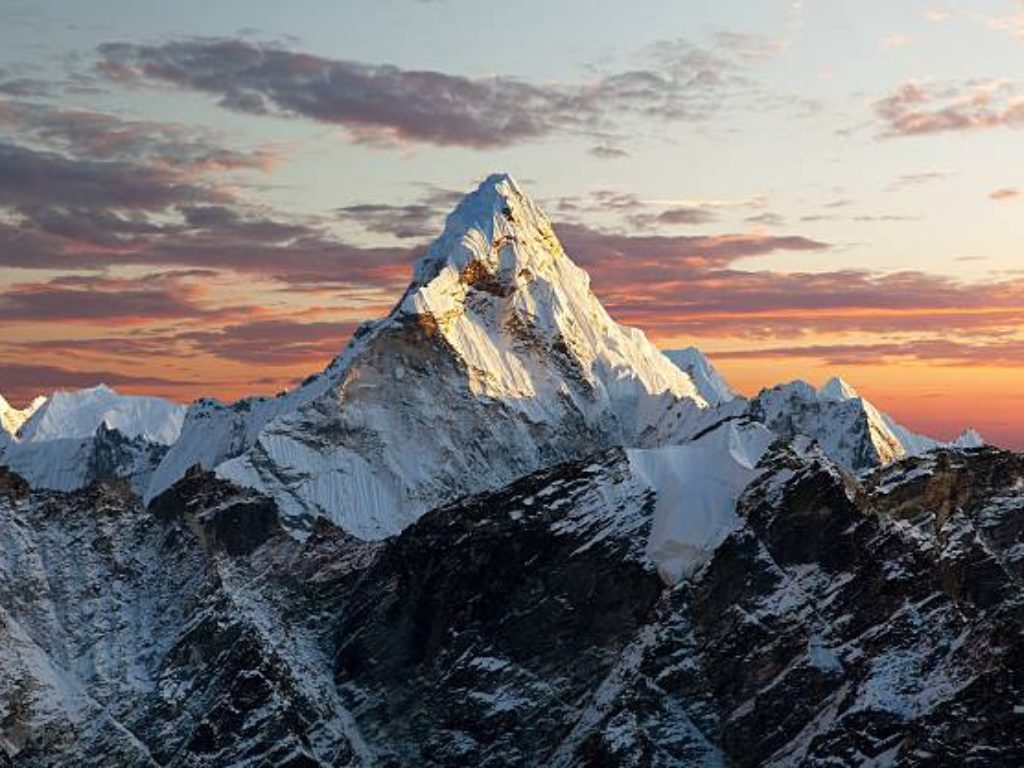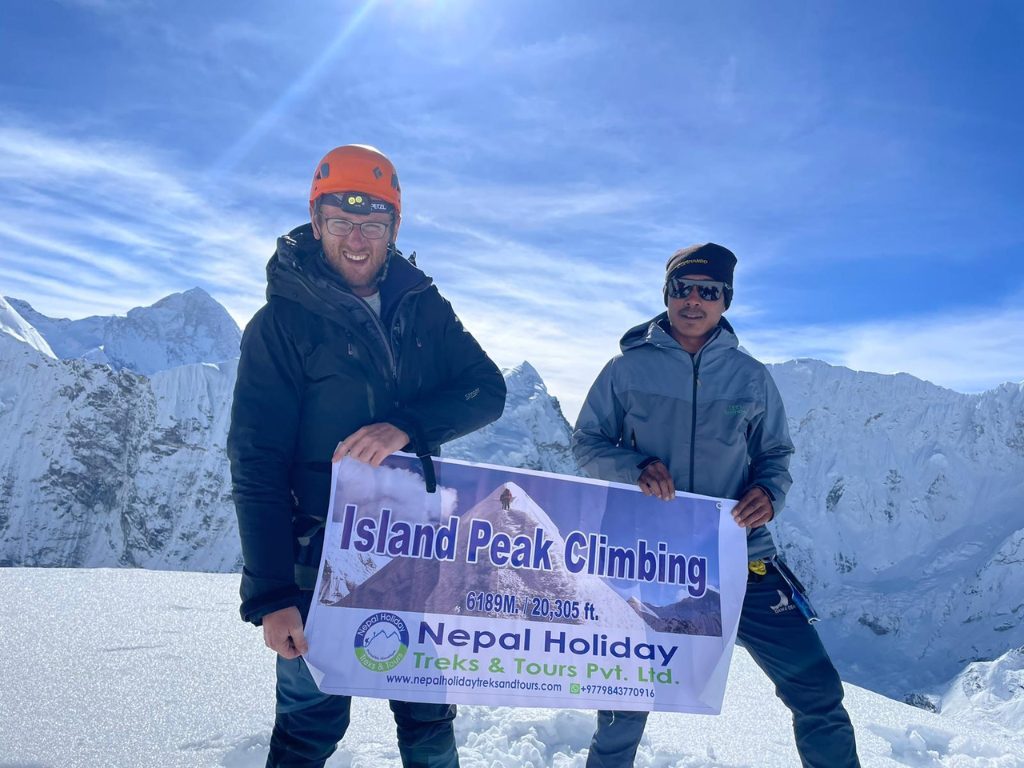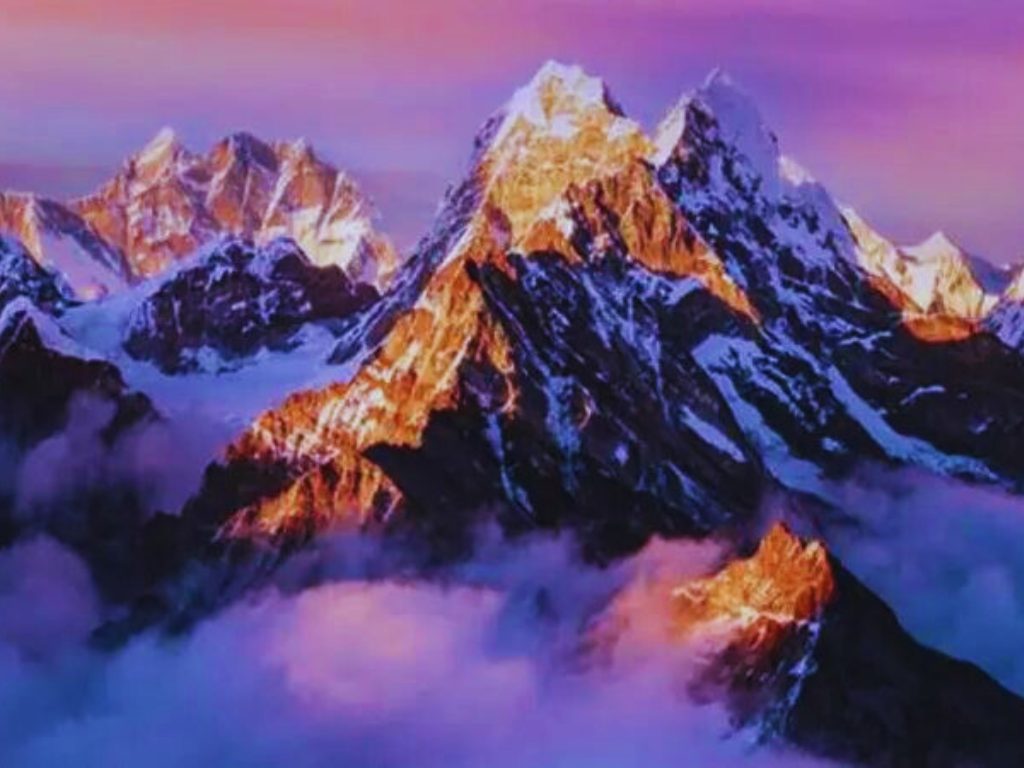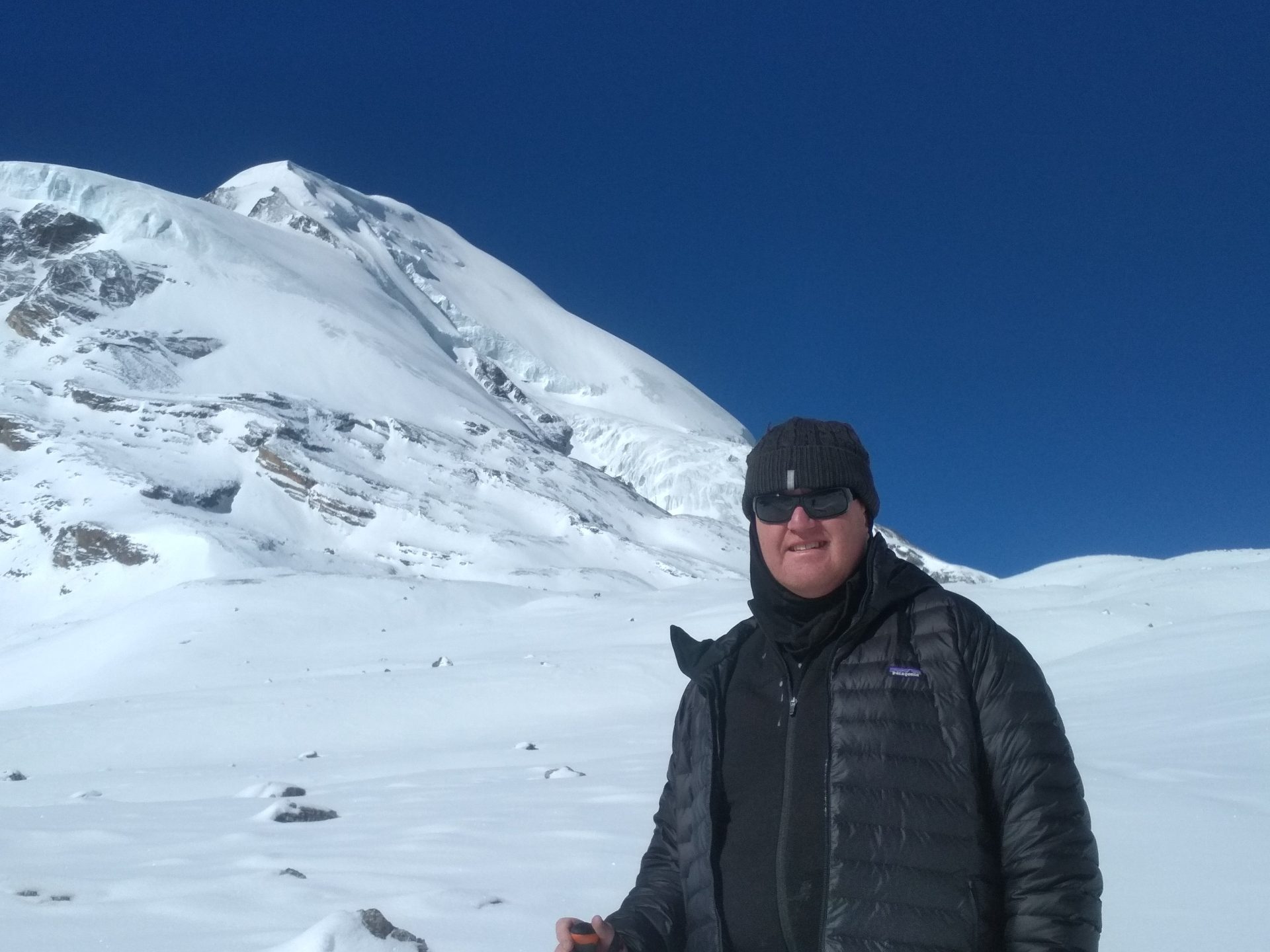Island Peak Climbing Overview
Island Peak Climbing, or Imja Tse as it’s known locally, stands at 6,189 meters and is one of Nepal’s most visited climbing peaks. It’s an ideal excursion for those in excellent physical condition and with an adventurous spirit wishing to challenge themselves in the high Himalaya. The peak was dubbed “Island Peak” in 1951 by British climber Eric Shipton due to its striking isolation, like an island in a sea of glaciers spilling down from nearby 7,000m and 8,000m giants. It has remained a favorite climb since then, including by famous mountaineers Tenzing Norgay and Edmund Hillary.
The ascent of Island Peak is rewarding and panoramic. The summit ridge offers breathtaking views of Mount Everest, Lhotse, Ama Dablam, and Makalu. The climb of this peak is generally utilized as a stepping stone for those who aim to climb mountains above 7,000 meters. While physically demanding, Island Peak does not require high-level technical climbing skills, making it a great introduction to mountaineering. The successful ascent is an exhilarating experience, which offers stunning close-up views of the Himalayan giants.
Travel to Island Peak
The adventure begins with a spectacular flight from Kathmandu to Lukla. Hereafter, the trek follows a classic Everest trail, passing through Phakding, the Dudh Koshi Valley, and the bustling town of Namche Bazaar. Continuing further, the trek passes through Tengboche and Dingboche and then reaches Chhukung. From here, trekkers move to Island Peak Base Camp, where training sessions are conducted to familiarize climbers with mountaineering gear and techniques. Basic skills such as rope use, ladder use, and jumar use, as well as crevassed glacier travel, are covered in prep for the climb.
The entire trip usually lasts between 14 and 19 days, based on acclimatization schedules and other side excursions. Out of this, the summit attempt is normally on the 11th day following thorough preparation. While most trekking days involve 4 to 6 hours of walking, the summit attempt is the most strenuous, taking 12 to 13 hours of climbing across roughly 10 miles of rugged terrain, snowfields, glaciers, and steep slopes.
Best Time to do Island Peak Climbing
While traveling, choosing a best time to travel is always a assistance, which brings opportunities to success as well as memories to remember throughout a lifetime. Island Peak Climbing can be achieved all year round but we suggest this trip either in the spring or autumn seasons when the charm of this trek is optimal.
In spring season, the trekking trail offers magnificent views of mountains, luscious forests, multicolored meadows, and blooming rhododendrons. The weather is warm, sunny, and beautiful with a wide view of the Himalayas and a beautiful blue sky. The temperature rises to 15 to 17 degrees Celsius in the day and falls to -10 degrees Celsius during the night at an altitude of above 4,000 meters.
Fall/autumn is also the best time because of its stable and dry weather. Being post-monsoon, autumn/fall provides unrestricted views of the Himalayas as well as the valleys. It is a little chilly as compared to spring especially but is tolerable. The weather is pleasant with temperatures between 0 and 15 degrees. -15 degree lows at the end of November are not uncommon.
Summer/monsoon season is not ideal for Island Peak Climbing since the heavy rain makes the paths muddy and risky. The summer trekking is unproductive from the weather’s perspective too. Similarly, avalanches and landslides are the two potential natural disasters that, on very few occasions, make the journey unsafe.
December, January, and February are off-season and winter months for Island Peak Climbing. But with proper equipment, preparation, and an experienced climbing guide, it is possible, especially in December. December is the ideal month if you prefer trekking independently and prefer deserted terrain.
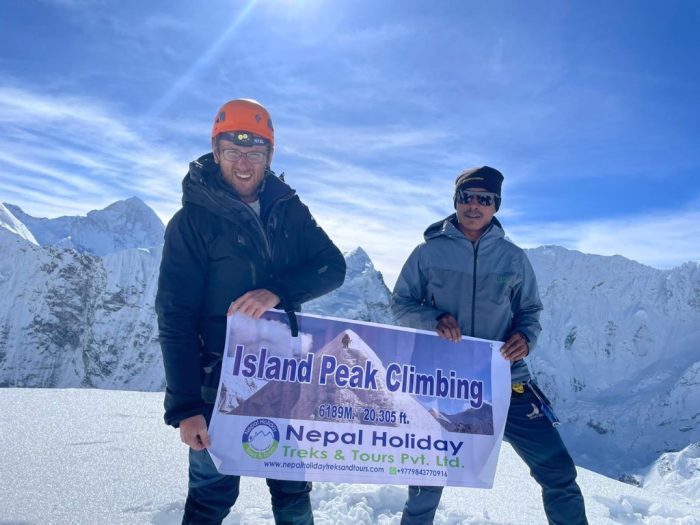
Challenges and Considerations During The Trek
Since the climb involves going up to a height of 6,189 meters, acclimatization is necessary to minimize the risk of altitude sickness. Spending several nights at a height of more than 3,000 meters necessitates climbers to take precautions such as hydration, adequate rest, and gradual acclimatization to the height. Some may prefer to take altitude sickness tablets like Diamox, as advised by a physician.
Changeable weather is another factor that can influence the climb. Therefore, choosing the right season—spring (March to May) or autumn (September to November)—greatly enhances the chances of a successful and safe summit.
The climb of Island Peak is challenging but rewarding, offering trekkers a chance to test their mettle, experiment with high-altitude mountaineering, and take in some of the most breathtaking Himalayan views. Whether as a freestanding trek or as a conditioning climb for higher altitudes, it’s an experience any mountain enthusiast will never forget.
Permits to do Island Peak Climbing
Climbers must buy the following permits to climb Mera Peak and Island Peak
1. NMA (Nepal Mountaineering Association) Permit
2. Sagarmatha National Park Entry Permit
3. Local Area Permit (Khumbu Rural Municipality Entrance permit)
All these permits are included in the package price.
Sagarmatha National Park Entry Permit
Since Everest Base Camp is located within Sagarmatha National Park,22 the trekkers need to pay an entry fee to access this protected area. The Sagarmatha National Park Entry Permit fee is:
- For foreigners: NPR 3,000 per person
- For SAARC nationals: NPR 1,500 per person
- For Nepalese: NPR 100 per person
This permit can be obtained at the Nepal Tourism Board Office in Kathmandu or at Sagarmatha National Park Entrance Gate in Monjo.
Khumbu Rural Municipality Permit
The Khumbu Rural Municipality Permit is the new Trekkers Information Management System (TIMS) Card for trekkers in the Khumbu area. The cost of the permit is as follows:
- For foreigners (including SAARC countries) for the first 4 weeks: NPR 2,000 per person
- For foreigners from beyond 4 weeks: NPR 2,500 per person
You can obtain this permit at the check post counters of Monjo or Lukla from the Khumbu Pasang Rural Municipality Office. Don’t forget that you have no other offices in Kathmandu where you can obtain this permit. But representatives of Trekking Planner Nepal can help obtain this permit to make your job easier.
Travel Insurance for a Safe Island Peak Climbing
Having reliable travel insurance is an essential element for a safe and hassle-free Island Peak Climbing adventure. Island Peak Climbing involves high-altitude trekking and technical mountaineering, and the insurance should be able to pay for medical issues, evacuation, and trip cancellations. Unexpected weather changes, altitude sickness, or accidents can occur during Island Peak Climbing, and full-scale insurance is thus required. It is recommended to take a policy covering helicopter rescue, as Island Peak Climbing routes are located in remote mountain regions. With sufficient cover, climbers can afford the exhilarating experience of Island Peak Climbing without worrying about sudden hazards.
Guide and Porters for the safety on Island Peak Climbing
Hiring experienced guides and porters is essential for safe and successful Island Peak Climbing. Professional guides ensure climbers use the safest routes and provide required technical support during Island Peak Climbing. Porters assist by handling loaded packs, so trekkers can conserve their energy for Island Peak Climbing. Professional guides can even assist in avoiding altitude sickness, which is most troublesome during undertaking Island Peak Climbing. With the right support staff, adventurers are able to boost their safety andexperience overall while indulging in Island Peak Climbing‘s magnificence
Healthy Meals at Island Peak Climbing
A balanced diet is needed to maintain strength and endurance during Island Peak Climbing. High-altitude trekking and climbing call for proper, balanced meals for energy and proper hydration throughout Island Peak Climbing. Balanced food, including carbohydrates, proteins, and fresh veggies, helps the climbers fight fatigue and altitude sickness at Island Peak Climbing. Hot and hygienic food must be consumed to remain free of any illness during Island Peak Climbing. Proper eating keeps the trekkers healthy and active, enhancing the overall experience of Island Peak Climbing as a whole.
Weather during on trekking time
Weather is crucial for the safety and success of Island Peak Climbing. The spring (March to May) and autumn (September to November) seasons are best for Island Peak Climbing with clear skies and stable weather. Severe winter weather and the monsoon season make Island Peak Climbing tougher due to heavy snowfall and unstable weather. Validation of the predictions and preparation for any surprise alteration is needed in Island Peak Climbing. The right gears and clothing protect the climbers from cold and insecurity, ensuring that Island Peak Climbing becomes easier and more comfortable.
Altitude Sickness on Island Peak
Normally altitude sickness occurs when you travel to a high altitude too quickly. Headache, Dizziness, loss of appetite, fatigue, shortness of breath, drowsiness, flatulence peripheral,fluctuation is body temperature, nausea, tiredness etc are the symptoms occur when your body tries to adjust to the lower air pressure and lower oxygen levels at high altitudes. Here are some things you can do to prevent yourself from getting altitude sickness.
- Stop and rest where you are
- ]Do not go any higher for at least 24 to 48 hours
- Make sure you are drinking enough water
- Do not smoke, drink alcohol, or exercise
- Eating foods and drinking fluids that contain carbs such as bread, pasta, fruits, milk, rice, and so on.
Preventing Altitude Sickness (AMS):
- Rest Well: Ensure that you rest well before starting your trek.
- Stay Hydrated: Continue drinking plenty of water during the journey.
- Balanced Nutrition: Maintain the balance of salt and sugar through proper eating habits and not skipping meals.
- Keep Warm: Layer up to remain warm without profuse sweating.
- Controlled Breathing: Breathe deeply and steadily from your diaphragm to maximize lung capacity. Maintain a comfortable walking speed that will allow for controlled breathing. Nasal breathing avoids drying your throat—wearing a muff or scarf in high altitudes might be of use.
- Pace Yourself: It’s not a competition. Pace yourself with a maintainable and Server consistent pace instead of exhausting yourself too early and taking many rest stops. Stop and admire the stunning views.
Island Peak Climbing Highlights
- Island peak standing at an altitude of 6189 m
- Stunning panoramic views of snow- capped mountains and spectacular landscapes
- Crossing glaciers, ascending steep snow slopes, and navigating through challenging terrain
- Passing through picturesque Sherpa villages, ancient monasteries, and stunning alpine landscapes
- We will provide you with a (20 degree sleeping bag) and a duffel bag for the trekking excursion, but you must return them after completing the trek.
- Experience the unique Sherpa culture and hospitality
- Interact with friendly local Sherpa people, visiting traditional Buddhist monasteries, and gaininsights into their way of life.
Important Notes
Nepal Holiday Treks and Tours Pvt. Ltd. has years of expertise in the field of Himalayan trekking and can curate unforgettable experiences for adventurers like you. In order for trekkers to have a really comfortable and pleasant Everest Base Camp Trek, we are offering different optional services as per your need.
Weather Condition during EBC Trek
The flight to Lukla is greatly dependent on fine weather and smooth conditions. Instable changes in weather usually bring in delays or postponements that might extend your trekking program. To cater for any unforeseen interruptions, we strongly recommend additional buffer days being included into the itinerary.
For long flight delays, helicopter transfer is also possible, but this comes at an additional cost and is not included in the general trek package. While helicopters do get to fly in some instances when planes cannot, extreme weather conditions will also see them grounded. If it becomes necessary, we can arrange a helicopter charter, although this is limited and on the basis of weather, as this too can cause delays.
Your tact and wisdom in such a situation are greatly appreciated. If the flights are grounded for a long period of time, another option is to drive by car to Tham Danda—a 20-hour grueling ride—where the trek can begin. But this trail too has its difficulties, particularly in inclement weather, with the necessity of added days and patience. If it becomes impossible to trek to Everest Base Camp due to recurring weather patterns, we can offer alternative trekking routes, such as Annapurna Base Camp or Langtang Gosainkunda. Although these routes do not end at Everest, they provide beautiful scenery and a rewarding trekking experience.
We thank you for your flexibility and understanding in dealing with these uncertainties, ensuring a worthwhile experience regardless of which route is taken.
Optional Add-Ons Available:
✅ Porter Service – USD $
Lighten your load and trek with ease! Our experienced porters can take up to 25 kg of luggage, which can be shared between two trekkers. Let the beauty of the landscape soak into you instead, without heavy gear.
✅ Kathmandu to Lukla Helicopter Flight – USD $
Avoid the pain of regular flights and start your adventure with a helicopter ride from Kathmandu to Lukla. This option offers breathtaking aerial views of the Himalayas while saving you time.
✅ Lukla to Kathmandu Helicopter Flight – USD $
Complete your trekking in style with a helicopter ride from Lukla back to Kathmandu. Ensuring a smooth return in comfort and with spectacular aerial views of the Everest Region, without risk of possible flight delays.
✅ Upgraded Accommodation – USD $
Upgrade your trekking experience with upgraded lodges featuring attached bathrooms at key locations: Phakding (1 night), Namche (3 nights), Tyangboche (1 night), Dingboche (2 nights), and Lukla (1 night). Enjoy added comfort after long days on the trail.
✅ Extra Night in Kathmandu – USD $/night
Arriving early or staying longer? Add extra nights at our partnered 3-star hotel in Kathmandu, including breakfast, to relax before or after your trek.
How to Customize Your IPC Trek:
- Choose Your Trek Departure Date.
- Mention the Number of Travelers.
- Click on ‘Book Now’ or ‘Add to Cart.’
- Choose Your Required Add-on Options.
- Complete Your Booking and Payment
Required Experience:
This trek is ideal for active trekkers who can hike 6 to 7 hours a day carrying a light daypack. On certain days, the trekking is longer and the altitude increases the difficulty level of trekking. The trails are generally good, but there could be boulder and uneven patches in between.
Itinerary and Schedule: We try to follow the itinerary planned; yet trekking in distant mountain regions means uncertainty. Factors such as weather and trekkers’ well-being may make readjustments necessary. Your guide and Sherpa crew will try to stick to the trail as designed but flexibility is a must. Your safety is our topmost priority and also to get you back to Kathmandu before your scheduled departure.
What will the temperature be like during trek?
Weather conditions can vary significantly depending on the season and can change rapidly, especially at higher elevations. If your trek takes you above 3,000m, you should be prepared for temperatures ranging from -10°C to 25°C in a single day. It’s essential to have proper protection against sun exposure and strong winds. For helpful weather insights, refer to reliable source. Feel free to reach out to us for a recommended packing list tailored to your trekking itinerary.
How much money should be we bring?
You’ll require Nepali Rupees for any expenditure not covered by your package itinerary. Such costs might include bottled water, night hot shower, extra snacks, extra hot drinks, repairing or replacing equipment, battery charging, souvenirs, and tips. In case you want to shop, Thamel is an excellent place to shop on your last day. You are welcome to come to our office prior to your trek for individual counsel and assistance with money exchange.
Electricity, telephone, and internet access are available at most lodges and guesthouses along the Island Peak Climbing Trek, but with some additional charges. While the trek itself does not have widespread access to electricity, many lodges rely on solar power or generators to provide energy. You can recharge your devices like cameras, mobiles, and laptops at these places, although it usually comes at an extra cost. If you need to make phone calls or access the internet, some accommodations offer limited telephone and Wi-Fi services. You can obtain an internet password from the lodge, but keep in mind that these services typically incur additional fees.
Fill your life with adventures, not things. Have stories to tell, not stuff to show. Hurry up! Adventure is waiting for you and mountains are calling you.
This trip is fully customization. Importantly, this trip is available on both a fixed departure and a private group basis. Moreover, we can also customize the trip as per your needs, please contact us at Whatsapp (+977-9843770916) or email us at [email protected]. Let us know how we can help you, and we will do our best to give you the best customer service you’ll get anywhere else.
Furthermore, Nepal holiday treks and tours Pvt. Ltd. is a reputable and reliable company serving relentlessly in the field of tourism to fulfill the dreams of diverse adventure seekers around the globe into reality where they can feel most alive. So, we recommend you to reserve seat for yourself by booking with us right away for a wonderful and unforgettable trip experience.
Island Peak Climbing Itinerary
Expand allDay 1: Flight from Kathmandu to Lukla (2,860m / 9,383ft) & Trek to Phakding (2,610m / 8,563ft) | 3-4 hours
You begin with an early morning flight from Kathmandu to Lukla, the most thrilling mountain airport in the world. Upon arrival, you are welcomed by your porter and guide, and the trekking starts. The trek descends through Sherpa villages and pine forests, along the Dudh Koshi River to Phakding.
Day 2: Trek from Phakding to Namche Bazaar (3,440m / 11,286ft) | 6-7 hours
The trek follows the Dudh Koshi River, and you walk across a number of suspension bridges, including the popular Hillary Suspension Bridge. Entering Sagarmatha National Park at Monjo, you ascend sharply through pine trees to reach Namche Bazaar, the bustling Sherpa capital of the Khumbu region.
Day 3: Stay on Namche Bazzar
Throughout your Namche Bazaar stay, start out in the morning strolling around the bustling local bazaar and paying close attention to a visit to the Sherpa Culture Museum for some understanding of the region’s history. Ascend to the Everest View Hotel for stunning panoramic views of Everest, Lhotse, and Ama Dablam. Visit the Sagarmatha National Park Museum to see the flora, fauna, and climbing history of the Khumbu region. Drink a cup of coffee at a cozy café and relish the breathtaking mountain scenery. At night, relax at a standard teahouse, socialize with local Sherpas, and prepare yourself for the second part of your trek.
Day 4: Trek from Namche Bazaar to Tengboche (3,860m / 12,664ft) | 5-6 hours
we will going to see the features great views of Everest, Lhotse, and Ama Dablam with a gradual ascent through rhododendron forest. A descent to Phunki Tenga brings the ascent steeply to Tengboche, site of the famous Tengboche Monastery, the largest in the region.
Day 5: Trek from Tengboche to Dingboche (4,410m / 14,468ft) | 5-6 hours
You trek along forest downhill to cross Imja Khola River and go up above the village of Pangboche. Tree line disappears as you climb higher, and you trek over alpine country to reach Dingboche, a beautiful valley situated between white mountains.
Day 6: Dingboche to Chhukung (4,730m / 15,518ft) | 3-4 hours
Short but important day for acclimatization. Trek follows gentle, gradual ascent through wide glacial valleys with terrific views of Island Peak and nearby mountains. Chhukung is the last village on way to Island Peak Base Camp.
Day 7: Rest & Acclimatization Day in Chhukung
On 7 Day it is crucial in terms of acclimatization to the high altitude. You can undertake short hikes to Chhukung Ri (5,546m / 18,196ft) to witness mind-blowing views of Makalu, Lhotse, and Ama Dablam. Your guide will also take time to conduct a final check of your climbing gear.
Day 8: Night Summit Attempt on Island Peak (6,189m / 20,305ft) & Return to Chhukung | 10-12 hours
In day 8 we are getting a challenging but rewarding climb. You start late at night, walking on glaciers and climbing fixed ropes under the direction of crampons and ice axes. Having ascended Island Peak after sunrise, you return to Chhukung, celebrating your victory.
Day 9: Chhukung to Tengboche (3,860m / 12,664ft) | 5-6 hours
Descend through familiar routes, passing through Dingboche and Pangboche before reaching Tengboche. You can visit the monastery again or rest amidst stunning views of the mountains.
Day 10: Tengboche to Namche Bazaar (3,440m / 11,286ft) | 4-5 hours
You retrace your steps, descending to Phunki Tenga, then follow the trail by the Dudh Koshi River, finally reaching the lively town of Namche Bazaar.
Day 11: Trek from Namche Bazaar to Lukla (2,860m / 9,383ft) | 6-7 hours
Your final day of trekking is spent in going down long distances, crossing suspension bridges, and trekking through villages before you reach Lukla. You and your guide and staff celebrate the completion of your successful trek.
Day 12: Flight from Lukla to Kathmandu & Departure
An early morning flight brings you back to Kathmandu, and you are free to stroll around the city, shop for souvenirs, or relax before your onward journey. Based on your flight schedule, you may either have some time in cultural places or have a farewell dinner.
If the above Everest Base Camp Trek itinerary does not meet your needs, we can design individualized travel plans based on your preferences and specifications.
Plan My TripIsland Peak Climbing Cost Includes
- Private vehicle by transfers in the hotel .
- Three times Three meals a day- Breakfast, Lunch, Dinner and 3 cup’s of tea/Coffee a day during the trek.
- Accommodation in tea house during the trek.
- In a day time tea break with cookies every day.
- Seasonally fruits and desserts on the trek after dinner every day.
- Nepal Holiday Treks and Tours, (-20 degree sleeping bag) and a duffel bag for the trekking, but you need to refund to the office after the trip.
- National park Trekking permits & local government permit and TIMS Card
- Domestic flight ticket to Lukla from Kathmandu or Ramechhap including airport transportation.
- An experienced, helpful, knowledgeable, friendly, English speaking well trained, government license holder Climbing Guide with all his salary, food, Drinks, accommodation, equipment, transport, and insurance.
- 3 nights accommodation in Kathmandu (3 star hotel) on the BB plan, 1 night before starting the trek and 1 night the day after returning from the trek.
- Climbing Gear: Crampons, Ice axe, Helmet, harness, Climbing boot, and Carabineers are included.
- Normal First aids kit box.
- You will be under observation with a pulse oximeter to have your oxygen levels and heart rate measured twice a day during the trek. This is to catch the signs of Altitude Mountain Sickness (AMS) early, thus making trekking safer.
- Nepal Holiday Treks And Tours trip completion certificate from the company side.
- Arrangement of Emergency helicopter service (paid by your travel insurance company)
- All the government taxes and company operating charges
Island Peak Climbing Cost Excludes
- International airfare and visa fees
- Extra days in Kathmandu and the mountains such as weather condition, flight delays, or strikes and health issues.
- Lunch and dinner in Kathmandu
- Equipment (sleeping bag, down jacket, and trekking pole)
- Personal expenses of bar and beverage (bills, WiFi, hot shower, extra porters, laundry, extra porters etc) or any other things which are not mentioned by the company.
- A strong, helpful, porters with proper safety equipment and walking equipment his salary, food, drinks, accommodation, insurance, (one porter for two people he will carry bag pack max 20-25kg).
- Travel insurance along with high-altitude emergency evacuation coverage
- Your trekking gears and extra nights in a certain destination
- Tips for your guide and porters which is compulsory.
- Entrance fees during the sightseeing
- Extra expenses due to any event
Upcoming Departures
Customer Reviews
Write a ReviewIsland Peak Climbing Equipment Lists
General info:
- Sleeping Bag and duffle bag: Four-season sleeping bag with a rating of -20°C by company after you have to refund on company.
- Insulated Jacket: A puffy and warm down jacket suitable for winter by company after you have to refund on company.
- Daypack: 25-30 liter backpack rain cover to carry one’s daily essentials
Clothing:
- Thermal base layers
- Trekking shirts (quick-dry)
- Fleece jacket and down jacket
- Waterproof jacket and pants
- Trekking trousers
- Gloves (inner and outer)
- Warm hat and sun hat
- Trekking socks
Footwear:
- Sturdy trekking boots
- Camp shoes/sandals
- Gaiters (optional)
Accessories:
- Trekking poles
- Backpack (50-60L) and daypack (20-30L)
- Sunglasses (UV protection)
- Headlamp with extra batteries
Water bottles and purification tablets
Similar Tours
Ama Dablam Expedition
The Ama Dablam Expedition is the most renowned and challenging Himalayan climb, yielding a hard-won experience for mountaineers. It...
Lobuche Peak Climbing From Lobuche – 3 Days
Lobuche Peak Climbing from Lobuche is an exciting adventure in the Everest region, offering climbers a thrilling experience amidst...
Island Peak Climbing From Chhukung – 3Days
Island Peak Climbing from Chhukung is a fantastic mountaineering challenge in the Everest region ideal for anyone willing to...
Short way to Mera Peak Summit
Mera Peak is an intriguing, high-altitude climbing peak in Nepal’s Solu Khumbu region. Despite being physically demanding, the 19-day...
Yala Peak Climbing
Yala Peak Climbing at Yala Peak, situated in the Langtang region of Nepal, is 5,500 meters above sea level....

